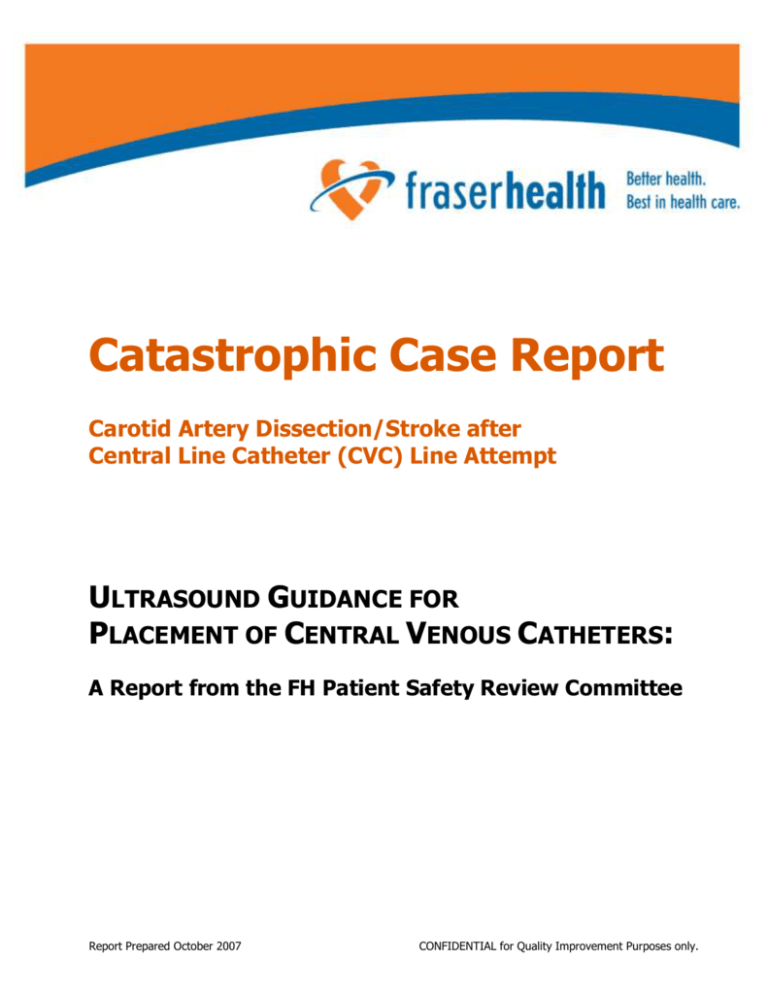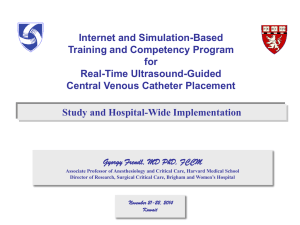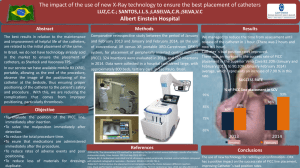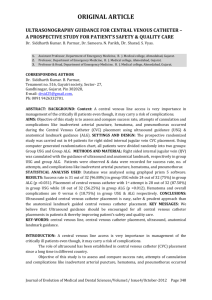(CVC) Line Attempt - Fraser Health Authority
advertisement

Catastrophic Case Report Carotid Artery Dissection/Stroke after Central Line Catheter (CVC) Line Attempt ULTRASOUND GUIDANCE FOR PLACEMENT OF CENTRAL VENOUS CATHETERS: A Report from the FH Patient Safety Review Committee Report Prepared October 2007 CONFIDENTIAL for Quality Improvement Purposes only. 1 ULTRASOUND GUIDANCE FOR PLACEMENT OF CENTRAL VENOUS CATHETERS Case Report A patient presented to hospital with abdominal pain and findings consistent with partial small bowel obstruction. Conservative treatment did not resolve the obstruction and the patient developed increasing signs of toxicity. An exploratory laparotomy revealed a strangulated, necrotic loop of small bowel requiring resection. During the procedure, the Surgeon advised the attending Anaesthetist of the need for central line placement to provide post-operative TPN. The Anaesthetist had examined the patient pre-operatively and noted signs of toxicity with tachycardia and possible fluid depletion. The procedure was going well and the Anaesthetist felt that placement of the central line under general anaesthetic was preferable to waiting until the end of the surgical procedure. The Anaesthetist initially attempted to place a right internal jugular line, without success. There was no venous flush noted on two attempts with a No. 23 ‘finder’ needle. A left internal jugular attempt was then attempted with ‘finder’ needle venous flush on the second puncture. The ‘access needle’ was then passed adjacent to the ‘finder’ needle to identify the internal jugular vein and allow placement of a J wire via Seldinger technique. Free flow of blood was not obtained using the ‘access needle’ and this attempt was also abandoned. Subsequently, a final attempt was made to place a left subclavian venous line; this, too, was unsuccessful and shortly after the attempt was abandoned, the patient developed decreasing oxygen saturations, difficulty with ventilation, decreased air entry in the left chest and hypotension. A chest tube was placed for pneumothorax. The surgical procedure was completed and post-operatively the patient did well, being moved in routine fashion to the surgical inpatient unit in good condition. During the next five to six hours, the patient developed progressive altered mental status with staring unresponsive behaviour; there was delayed recognition of progressive dysphasia/aphasia with a dense right hemiplegia. Investigations revealed a left common carotid artery dissection with complete occlusion of the vessel lumen. Comment Central venous access is a common procedure with an expected burden of untoward complications. Recent efforts by the “Safer Healthcare Now” campaign have looked at central lines, specifically addressing the issue of central line associated sepsis. A CVC bundle has been suggested as a method to standardize placement and reduce the inherent risks of the procedure. Key messages with regard to this bundle and its use are strict asepsis and use of a standardized approach. Traditional methods of CVC placement are based on a “blind anatomic” landmark-directed procedure. Recently, a significant body of literature has accumulated recommending that bedside ultrasound-guided access be used to reduce the number of attempts required to successfully place internal jugular (IJ) and femoral central lines. Subclavian lines, while preferable in some clinical instances, are not as amenable to ultrasound-aided approach as IJ and femoral lines. Minimizing mechanical complications from central lines requires that puncture attempts be minimized. Arterial puncture, other common complications such as nerve injury, pneumothorax, hematoma, and infection are avoided with reduced number of needle sticks. CONFIDENTIAL for Quality Improvement Purposes only. 2 Bedside Ultrasound Use in CVC Placement: Current Literature Scan In 2001, the US Agency for Healthcare Quality and Research (AHQR) placed ultrasound guidance for CVC placement as one of its top ten ways to reduce medical error. This annual document reviewed the literature and quoted a 20% rate for initial failed placement. The authors concluded, “real time ultrasound guidance for CVC insertion improves insertion success rates while reducing the number of attempts prior to successful placement and reduces the number of complications.” In September 2001, the National Health Service National Institute of Clinical Excellence published, Guidance on the Use of Ultrasound Locating Devices for Placing Central Venous Catheters. This extensive review reported industry failure rates of as high as 35% and recommended the following guidance: 1.1 Two-dimensional imaging ultrasound guidance is recommended as the preferred method for insertion of central venous catheters (CVC) into the internal jugular vein in adults and children in elective situations. 1.2 The use of two-dimensional imaging ultrasound guidance should be considered in most clinical circumstances where CVC insertion is necessary, either electively or in an emergency situation. 1.3 It is recommended that all those involved in placing CVCs using two-dimensional imaging ultrasound guidance should undertake appropriate training to achieve competence. The US Society of Cardiovascular Anesthesiologists, in its October 2002 newsletter, recognized that landmark-based placement is very successful in up to 95% of cases with experienced cardiovascular anesthetists. They noted that some cases required multiple attempts and further studies have demonstrated significantly higher rates of complication with more than two attempts at placement. Anatomical studies reveal up to 8.5% of patients have unusual neck anatomy conspiring to reduce the success rates for blind placement. The final conclusion of the Anesthetists’ document was, “the advantages of ultrasound guidance for central venous cannulation is making it more difficult to justify not using this technique in all patients.” In the intervening years, there have been a number of further studies supporting the adoption of bedside ultrasound guidance for placement for central venous catheters. A frequently quoted study by Lewis Eisen et al.1, documents a complication rate of 18.5%-39.5% overall (included failure to place). There were less complications with more experienced operators. A clear message from this study was the relationship between complication rate and multiple attempts. More than two punctures had the highest correlation with complications. Subclavian catheters had the highest rate of mechanical complications while the femoral vein has an up to 20% rate of infections and thrombotic complications. The weight of evidence suggests that IJ lines properly placed under strict asepsis with radiologic tip placement checks are the best alternative for central access. In experienced hands (over 50 prior IJ lines), an initial simple “blind” attempt to place an IJ is safe and reasonable. If the initial attempt is not successful, then ultrasound guided approach should be utilized for further IJ attempts (or the catheter placed elsewhere – subclavian or femoral vein). The following table reveals the extent of complications relating to CVC lines. For convenience, these are divided info infectious, mechanical and thrombotic. This discussion is focussed on the reduction of mechanical implications, but a bundled approach to CVC lines including strict aseptic technique with minimal puncture attempts will result in the greatest patient safety. 1 Eisen, Lewis A. et al. “Mechanical Complications of Central Venous Catheters.” Journal of Intensive Care Medicine. Sage Publications, 2006; 21; 40. CONFIDENTIAL for Quality Improvement Purposes only. 3 David McGee and Michael Gould2 identified Interventions to Prevent Complications: 2 McGee, David C. and Gould, Michael K. “Preventing Complications of Central Venous Catheterization.” The New England Journal of Medicine. N Engl J Med 2003;348:1123-33. CONFIDENTIAL for Quality Improvement Purposes only. 4 Case Study: Root Cause Analysis In this case, a number of potential contributing factors were identified that contributed to the carotid dissection and stroke. Content expertise was sought from cardiovascular, anesthesia and neuroscience colleagues. There was universal agreement that the likely initiating event for the dissection was intimal disruption of the common carotid artery after inadvertent puncture of the carotid by the ‘access needle.’ Contributing factors included: 1. Anatomy – the patient was malnourished and asthenic with recent fluid depletion. 2. Position – during the operative procedure, the patient could not be placed in the ideal position for CVC placement. 3. Setting – CVC placement attempts were made in the operating room with the patient draped, surgical procedure underway and the patient paralyzed. 4. Multiple Attempts – current literature suggests that any CVC that requires more than two attempts has a significantly higher rate of complications associated. 5. Timing – this was a non-emergency central venous catheter placement and the placement could have waited for a more controlled setting where variables that reduce the chance of success could have been minimized. 6. Left-side Pneumothorax – the episode with pneumothorax while under positive pressure ventilation, resulted in hypotension and relative hypoxemia. Once the pneumothorax was relieved, the patient then had a hyperdynamic response potentially subjecting the common carotid and its intimal disruption to a further stress. 7. Lack of Beside Imaging to Assist in CVC Placement – this increased the chance of failed placement. Discussion This case illustrates a rare, but significant, complication of CVC placement attempt. A review of causal factors suggests two primary contributing factors: 1. Multiple attempt at placement of a central line for non-emergent purposes in a less than ideal setting. 2. Lack of availability for bedside ultrasound to assist with successful placement of central venous line. The advent of portable, reliable bedside ultrasound devices has revolutionized the practice of bedside care in many areas of clinical medicine. Limited ultrasound exams can aid physicians in diagnosis and optimize the chance of success for a number of procedures. In reviewing the literature and discussing the utility of bedside ultrasound for CVC placement, it is clear that there is a move towards accepting the use of these devices to assist in many CVC placements. Physicians who have large case experience in CVC placements (greater than 50) and who have a high success rate on first punctures (e.g. cardiovascular anaesthetists) may elect to reserve USS, if there is a failure on first puncture attempt. CONFIDENTIAL for Quality Improvement Purposes only. 5 Recommendations 1A. Except in emergency insertions, CVC lines should be placed in optimal conditions. This includes: • • • • • 1B. adequate personnel to assist; ideal positioning; maximal sterile precautions; a bundled approach to insertion; and technological (ultrasound) assistance as needed. Sites should improve safety of central line placements by: 1B.1. Performing a local needs assessment, with development of a central venous line service complimenting those needs. 1B.2. Obtaining bedside ultrasound equipment to facilitate best practice. 2. Physicians placing CVC lines should familiarize themselves with this technology and incorporate its use into their practice by participating in CME on ultrasound guidance for central line placements. A Practice Opportunity Clinicians practicing in this era have been blessed with a robust research industry and rapidly evolving improvements in the resources available to provide modern patient care. New surgical procedures, adoption of evidence-based strategies and technological advances in imaging have all added to the quality agenda. Safe use of CVC lines is one of the key targets identified in the Agency for Healthcare Research & Quality. When considering the development of these recommendations, that respected body considered the potential for impact of the practice, the strength of the evidence supporting the practice and the implementation issues surrounding the practice change. Of their “11 clear opportunities for safety improvement” three related to CVC lines: 1) Use of maximum sterile precautions while placing CVC lines; 2) Use of real time ultrasound guidance during central insertions; 3) Use of antibiotic-impregnated central venous catheters to reduce catheter-related infections. By creating a standard CVC bundle and adoption of bedside ultrasound technology, clinicians will be demonstrating their deep desire to play a significant role in improving patient quality and safety. Change is rarely easily, but when change is demanded because of the moral imperative to improve, it becomes a welcome endeavour. It is the intention to monitor success in this effort by reviewing the current status of CVC line placements and following this with a one and two-year review as the unfolding change process matures. Success will be evidenced by high adoption rates and documented reductions in CVC line complications. CONFIDENTIAL for Quality Improvement Purposes only. Reference Materials Ashar, Tom. “Ultrasound Guidance for Placement of Central Venous Catheters.” Israeli Journal of Emergency Medicine. Volume 7, No. 2, June 2007. Brederlau, J. et al. “Ultrasound-guided cannulation of the internal jugular vein in critically ill patients positions in 30° dorsal elevation.” European Journal of Anaesthesiology. Cambridge University Press, 2004, 21:684-687. “Correspondence.” Anesthesiology. American Society of Anesthesiologists, Inc. Lippincott Williams & Wilkins, Inc. 2007;107:1032-3. Eisen, Lewis A. et al. “Mechanical Complications of Central Venous Catheters.” Journal of Intensive Care Medicine. Sage Publications, 2006; 21; 40. Fox, Dr. J. Christian. “SonoSite Micromaxx™ in the ED: A New Standard of Emergency Care.” Available online at www.sonosite.com/emergencymedicine. “Guidance on the use of ultrasound locating devices for placing central venous catheters.” Technology Appraisal Guidance – No. 49. National Institute for Clinical Excellence. September 2002. “Making Health Care Safer, A Critical Analysis of Patient Safety Practices: Summary.” Evidence Report/Technology Assessment: Number 43. Available online at http://www.ahrq.gov/clinic/ptsafety/summary.htm, downloaded August 27, 2007. McGee, David C. and Gould, Michael K. “Preventing Complications of Central Venous Catheterization.” The New England Journal of Medicine. N Engl J Med 2003;348:1123-33. Rothschild, Jeffrey M. “Chapter 21. Ultrasound Guidance of Central Vein Catheterization.” Available online at http://www.ahcpr.gov/clinic/ptsafety/chap21.htm, downloaded Aug 27, 2007. Sharma, Wg Cdr RM et al. “Ultrasound Guided Central Venous Cannulation.” MJAFI. Volume 62, No. 4, 2006. To, Edward W. H. et al. “Vascular Complications of Central Venous Line Insertion.” Available online at http://www.excerptahk.com/AJS/25_07/25_07_pdf/247.pdf, downloaded April 6, 2007. “Ultrasound guided central venous access” Letters, BMJ. BMJ 2003; 326:712 (29 March). Available online at http://www.bmj.com/cgi/content/full/326/7391/712, downloaded June 13, 2007. “Ultrasound guided central venous access” Rapid Responses, BMJ. BMJ 2002; 325: 1373-1374. Available online at http://www.bmj.com/cgi/eletters/325/7377/1373, downloaded June 13, 2007. Vernick, William and Augoustides, John G. “Ultrasound-Guided Central Venous Cannulation.” Newsletter, Society of Cardiovascular Anesthesiologists, October 2002. Wood, Jay R. et al. “Using Ultrasound for Central Venous Line Placement (CVP) in the Emergency Department.” Academic Emergency Medicine. 2001. Volume 8, Number 5 580. CONFIDENTIAL for Quality Improvement Purposes only.

![Jiye Jin-2014[1].3.17](http://s2.studylib.net/store/data/005485437_1-38483f116d2f44a767f9ba4fa894c894-300x300.png)






